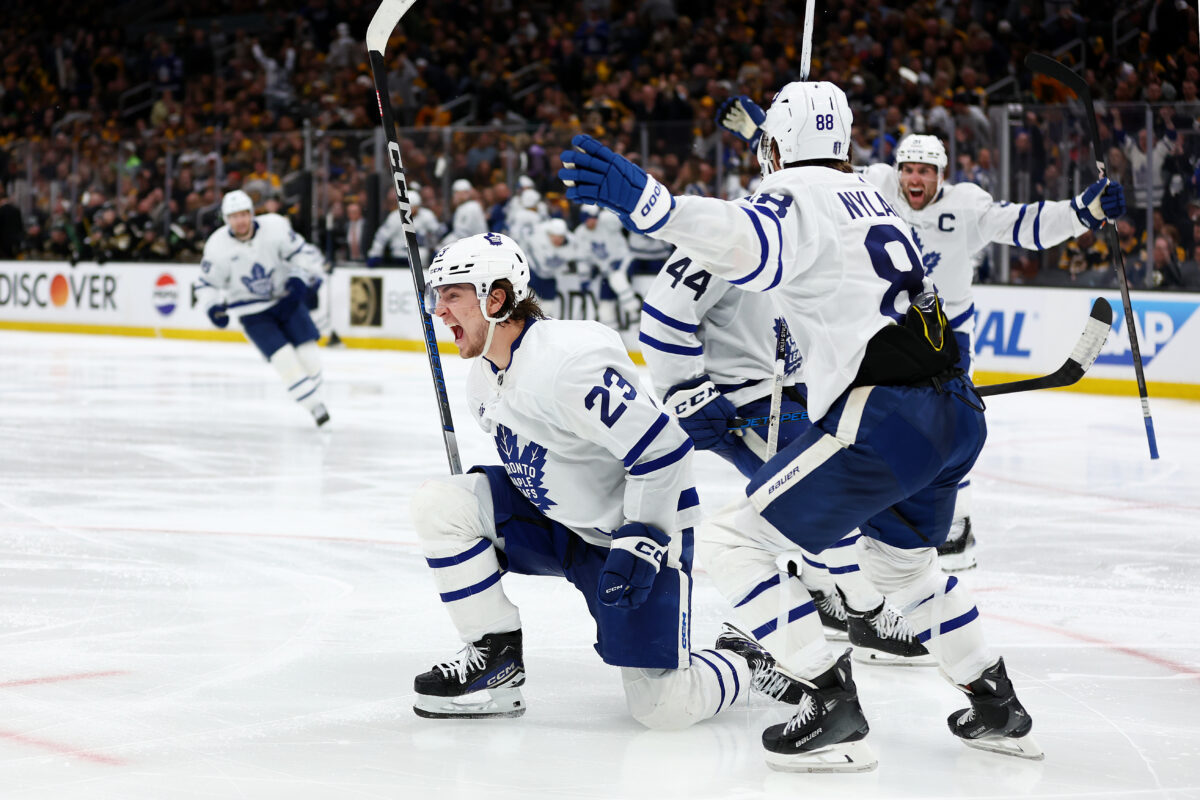The Toronto Maple Leafs have completed their first ten games of the season, offering fans and coaches a chance to evaluate the team’s forward lines. Early-season assessments reveal strengths, areas for improvement, and some hard choices ahead. Here’s a breakdown of which players have been most effective, who is on the bubble, and the key factors influencing lineup decisions moving forward.
Maple Leafs Forwards Consistency and Health so Far
One of the Maple Leafs’ biggest advantages this season has been consistency in their lineup. Except for John Tavares missing time due to illness, the forward corps has remained remarkably stable. Health and stability have allowed the team to build chemistry, particularly within the top two lines. This continuity has given head coach Craig Berube the flexibility to experiment with different combinations for the bottom six without worrying about disrupting the top players’ rhythm.
Related: Maple Leafs’ Promising Era of Defence Has Fizzled Out
The season is still young, but having a near-full lineup over the first ten games has been invaluable for the Maple Leafs, especially as they continue to assess new players and make adjustments for depth roles. It has also allowed for a deeper evaluation of each player’s contributions and consistency.
Evaluating the Core: The Top 7 Players
Seven players are essentially “locks” in the Maple Leafs’ lineup, and they’ve played every game except Tavares’ one absence. These core forwards include Auston Matthews, Mitch Marner, William Nylander, Tavares, Max Domi, Matthew Knies, and newcomer Steven Lorentz. Each has delivered consistently. Matthews, Marner, and Nylander continue to lead the team in points. Matthews’ offensive firepower and Marner’s playmaking abilities have defined the top line, while Nylander’s speed and creativity have been essential on the second line alongside Domi and Tavares.

(Photo by Maddie Meyer/Getty Images)
This group of seven forwards represents the offensive backbone of the team, balancing scoring ability with defensive responsibility. Domi’s versatility, Knies’ impressive early-season form, and Lorentz’s defensive play have helped solidify this core. The coaching staff’s confidence in these players is clear from their ice time, which averages well above the rest of the forward group.
The Odd Man Out: Who’s Fighting for a Spot?
With these top seven players secured, the focus shifts to the competition among the remaining six forwards vying for five available spots. Max Pacioretty, Bobby McMann, Nicholas Robertson, Pontus Holmberg, David Kampf, and Ryan Reaves have all had chances to show their skills. Here’s a quick look at their contributions based on goals, assists, and their plus/minus rating:
| Player | Games Played | Goals | Assists | Points | Plus/Minus |
| Max Pacioretty | 7 | 2 | 3 | 5 | +4 |
| Bobby McMann | 9 | 3 | 1 | 4 | +5 |
| Nicholas Robertson | 9 | 0 | 1 | 1 | +2 |
| Pontus Holmberg | 9 | 0 | 1 | 1 | -3 |
| David Kampf | 9 | 0 | 1 | 1 | -4 |
| Ryan Reaves | 8 | 0 | 0 | 0 | -3 |
Related: NHL Rumors: Oilers, Utah, Red Wings, Canucks, Flames
At first glance, Pacioretty and McMann have made the strongest case to stay in the lineup. They have each contributed offensively with solid plus/minus ratings. While low on points, Robertson has maintained a positive plus/minus, indicating he’s been defensively responsible. However, Kampf, Holmberg, and Reaves have struggled to consistently impact the scoresheet, raising questions about their roles as the season progresses.
Advanced Stats: The Effectiveness Factor (EF%)
To go beyond traditional statistics, it’s worth examining each player’s Effectiveness Factor (EF%). This measure combines key advanced stats—on-ice 5-on-5 goals-for percentage (GF%), expected goals-for percentage (xGF%), and high-danger scoring chances for percentage (HDCF%)—to assess each player’s impact:
| Player | GF% | xGF% | HDCF% | EF% |
| Max Pacioretty | 85.7% | 56.7% | 54.3% | 65.6% |
| Bobby McMann | 72.7% | 41.3% | 52.6% | 55.5% |
| Nicholas Robertson | 66.7% | 50.6% | 51.5% | 56.3% |
| David Kampf | 25% | 54.2% | 54.5% | 44.6% |
| Pontus Holmberg | 25% | 38.1% | 40.7% | 34.6% |
| Ryan Reaves | 0% | 47.3% | 50% | 32.4% |
A positive EF% over 50% signals a player’s ability to contribute to team success. With an impressive 65.6% EF%, Pacioretty stands out among the bottom-six forwards, supported by a high GF% of 85.7%. McMann and Robertson also register positive EF% scores, showing a balanced contribution in all three areas.

On the lower end, Kampf, Holmberg, and Reaves have EF% scores below 50%, indicating they have struggled to deliver measurable impact. Reaves, with an EF% of just 32.4%, has particularly faced difficulties establishing his role beyond physicality despite his 24 hits. Kampf and Holmberg’s low GF% show the Maple Leafs’ challenges with goal production in the bottom six, a potential issue if injuries or fatigue affect the top lines.
The Bottom Line: Ranking the Bottom-Six Forwards
Based on the EF% and traditional stats, Pacioretty, McMann, and Robertson have each shown value in keeping their roster spots secure. However, Kampf, Holmberg, and Reaves might find their roles shifting as the Maple Leafs face upcoming lineup decisions, including potential returns from injured players like Calle Jarnkrok and Connor Dewar.
Related: Former Maple Leaf Nic Petan: Where is He Now?
The following steps will likely involve experimentation and match-up-based rotations as Berube and the Maple Leafs coaching staff evaluate these players. Pacioretty effectively leads the pack. He has shown great chemistry with Tavares and can score. McMann and Robertson also show promise, suggesting the Maple Leafs’ bottom six might remain dynamic as they continue fine-tuning for a deep playoff run.
[Note: I want to thank long-time Maple Leafs fan Stan Smith for collaborating with me on this post. Stan’s Facebook profile can be found here.]

